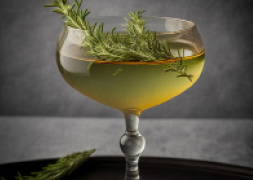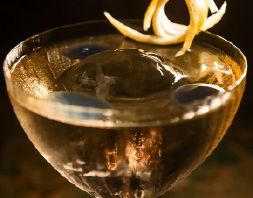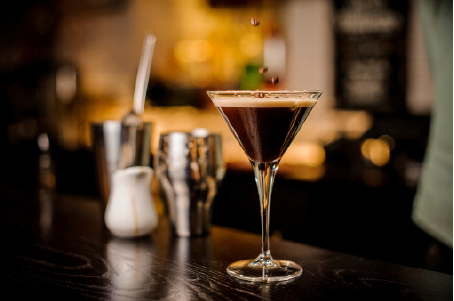Shaken. Stirred. Wet. Dry. Dirty. Vodka. Gin.
When it comes to martinis, there’s a lot of different choices to make, and a lot of differing opinions on what makes a good one.
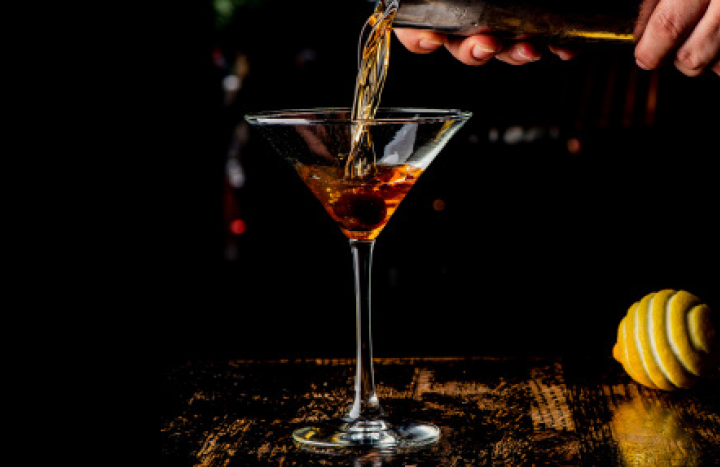
“I think one of the reasons that people are sort of intimidated by the drink is that it comes with this folklore, this mysticism, that it’s this iconic drink you can’t mess with,” says Claire Smith-Warner, head of spirit creation and mixology at Belvedere Vodka in an article for Tales of the Cocktail. “But all of these different possible ways that you can enjoy it makes this drink one of the most personable drinks that there is.”
According to the Tasting Table, these 15 appetizers pair perfectly with a martini: tuna tomato, crab cakes, onion rings, tabouli salad, steak tartare, sautéed mushrooms, bruschetta, steak bites, wedge salad, olives, crudité, deviled eggs, stuffed celery, oysters, and shrimp cocktail.
No matter which camp you fall into though (traditionalist versus those who like to experiment), martinis have continued to stand the test of time (thanks in no small part to James Bond).
“If you know how to make a martini, everything else will be fantastic,” said Nicola Olianas (Fratelli Branca Distillery Global Ambassador) during Tales of the Cocktail 2022 (TOTC) during a session on vermouth. “A martini is almost an entry level for everything else.”
The classics
Martinis are one of the simplest cocktails to create, since they are essentially composed of only two ingredients (vermouth and a base spirit).
“They’re the star of a drink like this,” says Gui Jaroschy with Unfiltered Hospitality.
However, the fact that it’s so spirit-forward makes it surprisingly complicated to balance this delicate drink.
“When you taste a martini with all these different ratios, it’s clear that even the smallest amount of sugar in a dry vermouth, and the acidity and the texture that the dry vermouth provides to that drink is the difference between a well-balanced cocktail and just a cold glass of gin,” said Matt Belanger (Death & Co) during TOTC 2022. “That ingredient is so important to making it taste like a cocktail, like something you want to drink. It gives structure on your palate.”
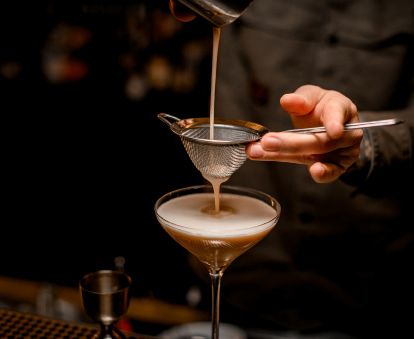
Additionally, the martini’s ingredients can be combined in so many different ways that no two martinis will ever be the same.
“It’s not a one size fits all,” said Kurt Rogers (Bodegas Lustau) during TOTC 2022.
Here are some the most common styles of martini:
The dry martini
A dry martini is one that uses less vermouth as opposed to more.
The wet martini (or 50/50 Martini)
This version is all about the ratios with equal parts spirit and vermouth.
“The 50/50 martini and its prevalence today kind of shows the evolution of the martini,” said Claire Sprouse (Buddy) during TOTC 2022.
The dirty martini
This version includes olive juice for extra flavor.
While dry, dirty, and wet may be the most “classic” styles of martini, a few others are also making a splash.
The Original Martini cocktail
Made with equal parts gin and vermouth with dashes of bitters, curacao, and syrup.
The Classic Martini
A 2:1 ratio of gin and dry vermouth with a couple dashes of bitters
The Perfect Martini
Gin and equal parts sweet and dry vermouth
The Reverse Martini
Where the amount of gin and vermouth are flipped.
The imposters
One style of martini that has become very popular among consumers, but is oftentimes controversial among martini enthusiasts, bartenders, and mixologists, are the “dessert martinis,” such as the chocolate martini, espresso martini, and lemon drop martini to name just a few. These drinks are often considered “imposters” by martini purists.
"To be clear, these aren't actual martinis since they don’t follow the traditional structure,” says Chris Tunstall with A Bar Above, “but they are served in martini glasses, after all, and they do have their own places in the cocktail world.”
In fact, according to research firm CGA by NielsenIQ, the Espresso Martini was one of the 10 most ordered cocktails at bars in the United States this year, bumping the Manhattan off the list.
“Consumers are drawn to the simplicity and decadence of this cocktail,” said Lisa Hawkins, senior vice president for public affairs for the Distilled Spirits Council in an article for CNN Business. “The elegance of the espresso martini elevates your cocktail experience at a bar or restaurant, and it also serves as an impressive after-dinner cocktail when entertaining guests at home.”
Stirred, never shaken
Now, no offense to James Bond, but mixologists around the country agree that the proper way to make a martini is stirred, never shaken.
“You're looking to achieve both chill and a little bit of dilution,” according to an article on Martha Stewart’s website. “Shaking it will agitate the liquids and leave shards of ice, ruining that pretty, clear-as-glass effect that the martini is famous for.”
“You're looking for a nice balance of flavors between the spirit, vermouth, and possibly bitters,” says Jaroschy. “I want it nice and cold, but not over diluted.”
How to Batch a Martini for a Crowd
If you’re catering a party and want to serve martinis, it’s highly suggested to pre-batch them rather than having a bartender create them one-by-one.
“Pre-batched freezer martinis are definitely coming into vogue at high-end restaurants and mixology bars,” says Gui Jaroschy with Unfiltered Hospitality.
For pre-batching, you’ll need to scale the recipe by the number of serves, and then combine all the ingredients beforehand, adding water for dilution (approximately 15%), and then refrigerate at least six hours before the event.
This way, your cocktail is already mixed, chilled, and diluted, so all you need to do is pour it into your guests’ glasses. It’s that simple. Just be sure your ratio is consistent with that of the original cocktail recipe, and don’t forget to dilute.
Information courtesy Chris Tunstall, A Bar Above
In fact, according to TOTC, when gin martinis are shaken (not stirred), the high velocities can have scientifically proven negative impacts.
“Any complex mixture of odors is generally divided into three parts: top note (in perfumes this is also known as the head note), middle note (heart note) and base note or fixative,” said Shannon Stewart, a research scientist at Massachusetts Institute of Technology, in the TOTC article.
“So, when you agitate gin—say by shaking it for a martini—you’re causing the top notes to dissipate,” according to TOTC. “Those bits of pine and botanicals that you look forward to start breaking down and become dull. The end result: A cocktail that’s nowhere near as crisp as it should be.”
“This is what we call bruising,” Stewart said. “Once you’ve shaken it, the rest of the drink only contains middle and base notes. Yuck.”
Many martini enthusiasts also agree that temperature also plays a pivotal role; in fact, many suggest keeping your vodka, gin, and glasses in the freezer, while storing the vermouth in the refrigerator.
“That way you can chill the cocktail to perfect temperature without overdiluting,” Jaroschy says, “and the glass keeps the drink cold for the first crucial sips rather than warming it up.”
Mixing it up
With so many different takes on a martini, the question becomes: what makes a good martini? And when does a martini stop being a martini?
“From my perspective, martinis must be spirit-forward, made with a neutral-ish base spirit, a fortified wine (e.g., vermouth, sherry, wine, sake, etc.), bitters or tinctures, and, in some cases, a hint of sweetness,” says Jack Sotti, head bartender at Sweeties at The Standard in London for an article with Liquor.com. “A much more basic way of putting it: it must look like a martini and feel like a martini when you drink it.”
For Jaroschy, the appearance of a martini is almost just as important.
“When I see a gin martini being poured into a glass that has a glistening almost jewel-like appearance, I know I'm getting a good one,” he says. “That visual cue lets me know I'm getting a cocktail with some mouthfeel and enough residual sugars to highlight the flavor of the base spirit rather than mask it.”
So, will martinis continue their auspicious career? All signs point to ‘yes.’
“The reason why the martini remains so relevant is that it is a delicious sipper and a very classy cocktail,” Tunstall says. “Next to champagne, the martini is a drink associated with class and wealth—both fictional and in reality—and everyone wants to feel posh at some point, even if for a moment, even if for a single drink.”
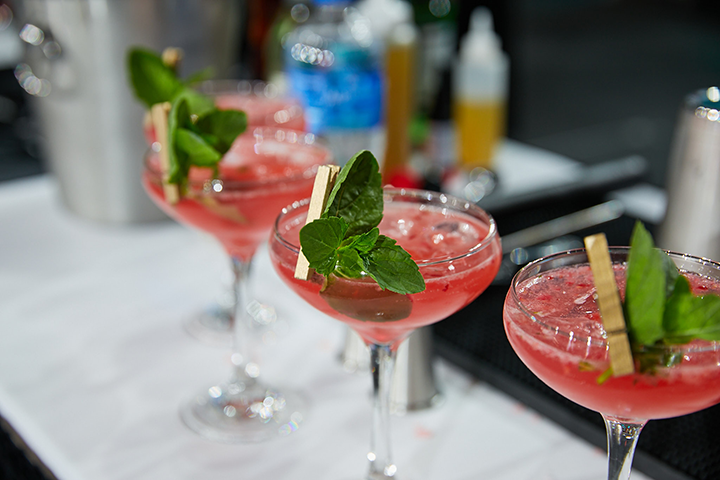
Photo courtesy WASIO Photography

Classic Dry Martini
Recipe courtesy the Star Tribune
Yield: 1
Ingredients
Method
Combine ingredients in a mixing glass filled with ice and stir vigorously until well-chilled. Taste frequently until mixture reaches desired flavor. If the alcohol is too assertive, let sit 30 seconds to allow ice to dilute the mixture, and stir again. Strain into a chilled martini glass. Garnish with a skewer of olives or a lemon peel.
Gin Élevé
Recipe and photo courtesy Chris Tunstall, A Bar Above
Yield: 1
Ingredients
Method
Combine all ingredients into a mixing glass. Add ice, and stir for about 15 seconds or until properly chilled. Strain into a coupe or Nick & Nora. Garnish with an expressed lemon peel.
Martini Penacho
Recipe courtesy Chris Tunstall, A Bar Above
Yield: 1
Ingredients
Method
Combine all ingredients into a mixing glass. Add ice, and stir for about 15 seconds or until properly chilled. Strain into a coupe or Nick & Nora glass. Garnish with a torched rosemary sprig—make sure it’s still smokey when serving.
Slip Away
Recipe and photo courtesy Gui Jaraschy, Unfiltered Hospitality
Yield: 1
Ingredients
Method
Pour ingredients into a mixing glass and stir until chilled. Place a large ice sphere into a chilled coupe and pour martini into glass. Express lemon twist over cocktail and place on rim. Gently drop 3 drops of spirulina/lime oil around ice sphere.
Naked & Dirty
Recipe and photo courtesy Gui Jaraschy, Unfiltered Hospitality
Yield: 1
Ingredients
Method
Batch all ingredients and rebottle. Store in the freezer at least six hours. At service, bring chilled glass with pimento olive and atomizer of pecorino spray. Spritz inside of glass twice at the table and pour ice cold martini to ¼” of rim.
Espresso Martini
Recipe courtesy Absolut Vodka
Yield: 1
Ingredients
Method
Fill a cocktail shaker with ice cubes. Add 1⅓ Parts Vodka, ⅔ Part Kahlúa, and ⅔ Part Cooled Espresso. Shake well to get the foam on top, and strain it into a cocktail or martini glass. Garnish by placing three coffee beans on top.

Know Your Bitters
Once a staple in apothecaries and pharmacies, bitters have long been a fixture behind the bar. With a booming market for small-batch bitters, there is now a seemingly endless well of flavors from which to choose. Nowadays, bitters range in flavor from Aztec chocolate to crabapple and cardamom.
What are bitters?
When discussing bitters, mixologists are most often referring to extracts—and they’re not the same as tinctures.
“Tinctures are technically one singular ingredient that’s extracted to create one flavor,” said Lauren Mote, co-creator of Vancouver-based Bittered Sling, for an article with Tales of the Cocktail. “Bitters are not a singular ingredient; they are a combination of ingredients that come together to add depth and complexity and to soften out the harsh edges of ingredients.”
The main different kinds of bitters used in cocktails are:
Orange/citrus bitters
Orange bitters are made from peels of Seville oranges, cardamom, caraway seed, coriander, anise, and burnt sugar. This type of cocktail bitters gives off the traditional marmalade scent with hints of bitter and sweet taste from the orange peel and alcohol combination. Suggested cocktails: Martini and Negroni.
Aromatic bitters
Based on its name, aromatic bitters are made from botanical ingredients that are known to exude different smells when crushed or mixed. Examples of aromatics used are cinnamon, mint, peppermint, hibiscus, lavender, valerian, lemongrass, and sage. Suggested cocktail: Manhattan, Old Fashioned, or Sazerac.
Nut bitters
Nut bitters are relatively new to the market.
But since mixologists and bartenders are quite experimental behind the bar, they came up with nut-flavored bitters that are made from coffee and chocolates.
Natural bitters
In the absence of preservatives and GMO, natural bitters exist. These are made from organic ingredients that are usually sourced in local farms.
Cocktail bitters
Bitters are commonly used to flavor cocktails. Because of their strong taste, they can balance out the sweet and sour notes of any beverage. Cocktail bitters are added in the form of drops or splashes in the drinks.
A few suggested pairings from Mote include:
- In general, aromatic bitters go well with oak-aged spirits
- Citrus-based bitters love white spirits and fresh ingredients like mint, basil, and cilantro
- Rich chocolate bitters play well with Cognac
- Celery bitters pair exceptionally well with sherry, sake, bourbon, and vermouth, and they do great things to a Rob Roy or Champs Elysees
Sources:



